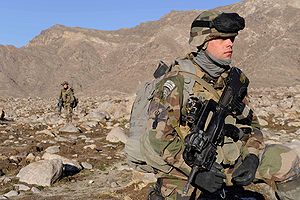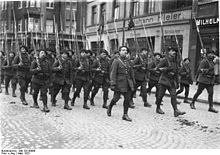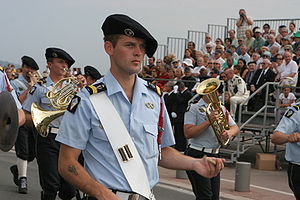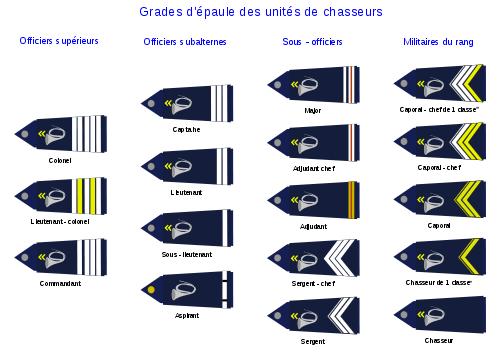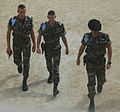- Chasseurs Alpins
-
Chasseurs Alpins
Chasseurs alpins in AfghanistanActive 1888 - Present Country  France
FranceBranch  French Army
French ArmyType Infantry Role Mountain Infantry Size Three battalions Garrison/HQ 7e Bataillon—Bourg-Saint-Maurice
13e Bataillon—Chambéry
27e Batallion—Cran-GevrierNickname Les diables bleus (Eng: The Blue Devils) Motto Jamais être pris vivant (Eng: Never to be Taken Alive)
Sans peur et sans reproche (Eng :Without fear and beyond reproach)Engagements Battle of Alasay The Chasseurs Alpins (English: Alpine Hunters) are the élite mountain infantry of the French Army. They are trained to operate in mountainous terrain and in urban warfare.
Contents
History
France created its own mountain corps in the late 19th century in order to oppose any Italian invasion through the Alps. In 1859, the former independent states of Italy such as the Kingdom of Naples, Republic of Venice or the Papal States were unified through the campaigns of Garibaldi and Cavour.
The French military saw this geopolitical change as a potential threat to their Alpine border, especially as the Italian military was already creating troops specialized in mountain warfare (the Alpini). On December 24, 1888, the first troupes de montagne (mountain troops) corps were created from 12 out of the 31 existing Chasseurs à Pied (Hunters on Foot) battalions.
Initially these units were named Bataillons Alpins de Chasseurs à Pied (Alpine Battalions of Hunters/Rangers on Foot). Later this was shortened to Bataillons de Chasseurs Alpins (Battalions of Alpine Hunters/Rangers). From their establishment the Chasseurs Alpins wore a plain and practical uniform designed to be suitable for mountain service. This comprised a loose-fitting dark blue jacket and blue-grey breeches, together with a large beret carrying the yellow bugle horn insignia of the Chasseur branch. They are believed to have been the first regular military unit to have worn this form of headdress.
Modern unit
Since 1999 they have been (with other units) part of the 27th Mountain Infantry Brigade (Brigade d'Infanterie de Montagne), and are currently organised into three battalions:
- 7th Battalion, Bourg-Saint-Maurice
- 13th Battalion, Chambéry
- 27th Battalion, Cran-Gevrier (Annecy)
All three battalions are based in cities in the French Alps, thus the name of the units.
Training includes climbing, cross-country skiing, plus winter and summer mountain leadership and mountain guiding skills. Traditional training included mountain survival skills such as to build an igloo shelter and to sleep in temperatures around 0°C. Modern troops may be transported in all-terrain VMBs, VACs, (Bandvagn 206) or untracked VAB personnel carriers. Personal weaponry includes the FAMAS assault rifle, Minimi machine gun, FRF-2 sniper rifle, PGM Hecate II heavy sniper rifle, and LGI light mortar, while group weapons included the M2 machine gun, LLR 81mm mortar, and vehicle-mounted 20 mm autocannon, plus AT4, ERYX and MILAN anti-tank missiles.
The Chasseurs are easily recognised by their wide beret (when not in battle uniform), named the tarte (after a type of pie).
Various Traditions
Chasseurs do not say rouge (red) but blue-cerise (cherry blue), except when speaking of the color of the lips of a beloved, the red in the Legion of Honour's insignia (including its fourragère which is called la rouge), and the red of the French flag. This stems from the days when Napoleon III tried to impose the wearing of the scarlet pantalons garance. The mountain troops objected, and no long use the word 'red' as a result.
The chasseurs have a few other typicalities in what they say:
- not jaune (yellow), but jonquille (daffodil);
- not uniforme (uniform), but tenue (outfit, or dress);
- not la musique (the music), but la fanfare (the band);
- the band does not joue (play), but ça sonne (it sounds);
- not tambour (drum), but caisse claire (snare drum);
- and not caserne (barracks), but quartier (neighborhood, barracks, or quarters).
The Chasseurs are said to have green blood, after the pun: "Le sang vert, c'est pour la France/Le sang versé pour la France" (Green blood is for France/Blood shed for France).
Choruses and Ringin
A hunter salutes when he hears the chorus of his battalion or battalion where he served during his career, when he Protest aims, established in 1873 in Chalons when the Law executives began questioning the existence of the battalions of hunters. The Alpine hunter salutes also when the Savoyards are sounded. A hunter salutes when the sounds Sidi Brahim.
Each battalion has a chorus of its own. These tunes are completely different from one another both in the tone of the text. Indeed, earlier battles of infantry without means of transmission, the bugler sounded his horn chorus. Thus, the general overseeing the fighting knew the position of their troops. Each new hunter must know the 32 choruses preserved to pass his "baptism hunter." Tradition dictates that each day number corresponds to a chorus hunter. For this reason it has 31 refrains, the first 31 battalions, and we kept it the 40th battalion was stationed in Madagascar. It is customary to sound the refrain every morning the day before the call to the company.
- 1er bataillon «Si l'septième de ligne a des couilles au cul, C'est qu'le Premier Chasseurs les lui a foutues!»
- 2e bataillon «Le Commandant a mal aux dents, mes enfants!» (bis)
- 3e bataillon «V'la l'troisième, v'la l'troisième, qui rapplique au galop, V'la l'troisième, v'la l'troisième, qui rapplique sac au dos!»
- 4e bataillon «Quatrième bataillon, Commandant Clinchant, Toujours en avant!»
- 5e bataillon «Cinquième Bataillon ventre à terre, Commandé par Certain Canrobert, en avant! »
- 6e bataillon «Le sixième est là, il est un peu là!»
- 7e bataillon «Bataillon, Bataillon, Bataillon de fer, Bataillon, Bataillon, Bataillon d'acier».
- 8e bataillon «T'as beau courir, tu ne m'rattraperas pas!» (bis)
- 9e bataillon «Marie, j'ai vu ton cul tout nu, Cochon, pourquoi le regardes-tu?»
- 10e bataillon «Dixième Bataillon, Commandant Mac-Mahon, N'a pas peur du canon nom de nom»
- 11e bataillon «Onzième Bataillon de Chasseurs Alpins, Onzième Bataillon d'lapins»
- 12e bataillon «Ah c'qu'il est con, c'qu’il est con l'Douzième, Ah c'qu’il est con, c'qu’il est con c'con là!»
- 13e bataillon «Sans pain, sans fricot, au treizième on n'boit que d'l'eau!»
- 14e bataillon «La peau de mes roulettes pour une casquette, La peau de mes rouleaux pour un shako!»
- 15e bataillon «Je fumerais bien une pipe, Mais je n’ai pas de tabac!»
- 16e bataillon «Seizième Bataillon d'Chasseurs à pied, Seizième Bataillon d'Acier!»
- 17e bataillon «Cré nom d'un chien, nous voilà bien partis, Cré nom d'un chien, nous voilà bien!»
- 18e bataillon «Encore un biffin d'enfilé, rompez, Encore un biffin d'enfilé !»
- 19e bataillon «Trou du cul, trou du cul plein de poils sales, Trou du cul, trou du cul poilu!»
- 20e bataillon «Vingtième Bataillon, Commandant Cambriels, Les Chasseurs à pied ont des ailes!»
- 21e bataillon «En voulez-vous des kilomètres ? En voilà!»
- 22e bataillon «Encore un biffin de tombé dans la merde, Encore un biffin d'emmerdé! »
- 23e bataillon «V'la le vingt-troisième, nom de Dieu, ça va barder!»
- 24e bataillon «Tout le long du bois, j'ai baisé Jeannette, Tout le long du bois, j'l'ai baisé trois fois!»
- 25e bataillon « Pas plus con qu'un autre nom de nom, Mais toujours autant!» (ou content)
- 26e bataillon «Tu m'emmerdes et tu m'fais chier, tu m'dis ça c'est pour blaguer!»
- 27e bataillon «Si vous avez des couilles, il faudra le montrer!»
- 28e bataillon «Saut'Putten ; t'auras d'la saucisse, Saut'Putten, t'auras du boudin!»
- 29e bataillon «C'est le Vingt-neuvième, qui n'a pas d'pain, Qui crève de faim, qui marche quand même!»
- 30e bataillon «Il était un p'tit homme, Tout habillé de bleu, nom de Dieu!» (ou sacrebleu)
- 31e bataillon «Trente-et-unième, l'dernier v'nu, Pas l'plus mal foutu!»
- 32e bataillon «Si j'avais du pinard, j'en boirais bien un goutte, si j'avais du pinard j'en boirai bien un quart!»
- 40e bataillon «Trou du cul de la reine des Hovas»
The flag
There is only one flag for all the battalions and groups of foot and alpine hunter, the guard was assigned to battalions bearing the red fodder for one year. The award is now at the Chateau de Vincennes, home of hunters. This act is simpler because it remains only four battalions and military mountaineering school. However currently the color guard is divided between the 7th, 13th and 27th battalion (16th now disbanded).
Ranks
Enlisted & NCO
- Chasseur (Hunter/Private)
- Chasseur de 1ère Classe (1st class Hunter/Private 1st class)
- Caporal (Lance Corporal)
- Caporal-Chef (Corporal)
- Caporal-Chef de 1ère Classe (Corporal 1st class)
- Sergent (Sergeant)
- Sergent-Chef (Staff Sergeant)
- Adjudant (Warrant Officer 2nd class)
- Adjudant-Chef (Warrant Officer 1st class)
- Major (Conductor or Sergeant Major)
Officers
- Aspirant (Cadet/Aspirant)
- Sous-Lieutenant (2nd Lieutenant)
- Lieutenant (1st Lieutenant)
- Capitaine (Captain)
- Commandant (Major)
- Lieutenant-Colonel (Lieutenant Colonel)
- Colonel (Colonel)
Note: the NCO ranks Brigadier and Maréchal-des-logis are not used in the Chasseurs Alpins corps.Gallery
-
The band of the Chasseurs alpins uses Alphorns
See also
- List of Chasseurs Alpins
- Ski warfare
- Military of France
- Germany: Gebirgsjäger
- Italy: Alpini
- Poland: Podhale rifles
- Romania: Vânători de Munte
External links
Categories:- French Army
- Mountain units and formations
Wikimedia Foundation. 2010.

